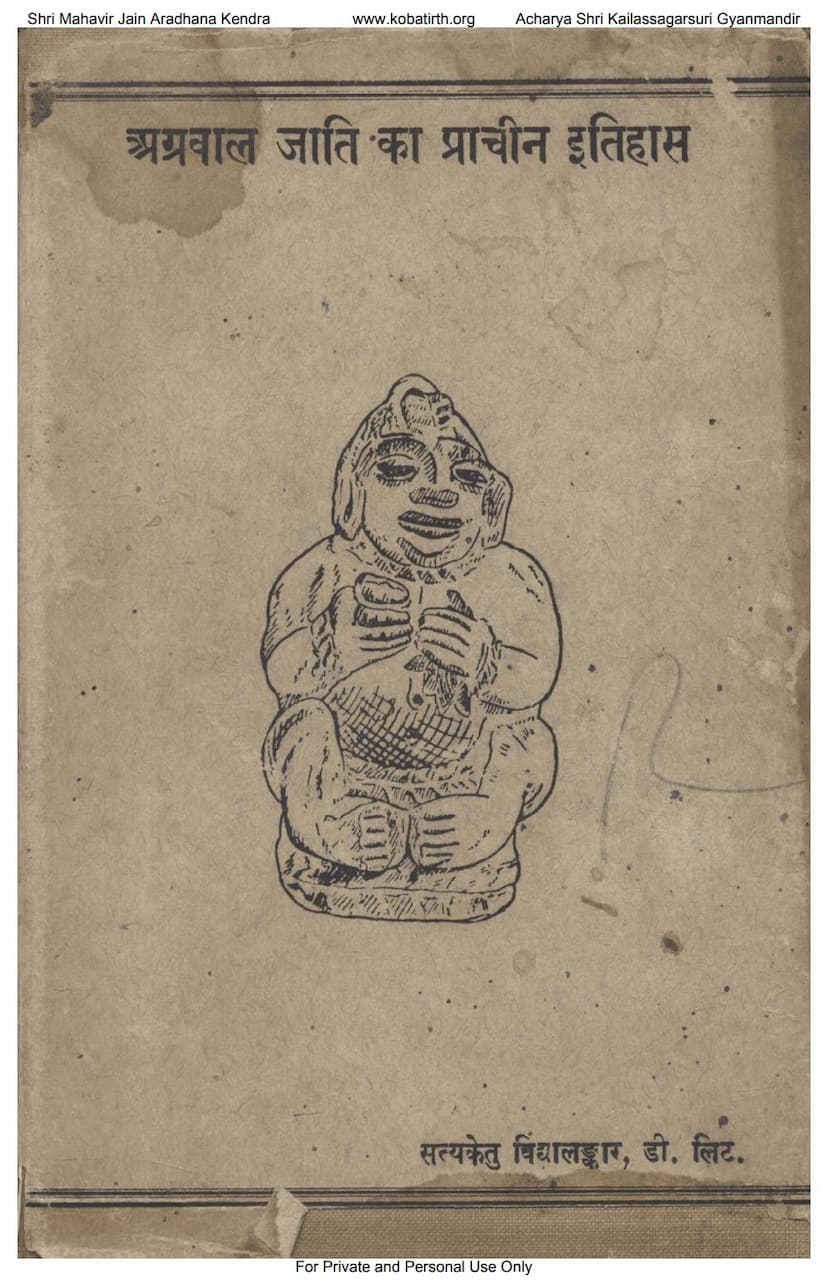Agarwal Jati Ka Prachin Itihas
Added to library: September 1, 2025

Summary
This document is a comprehensive historical treatise titled "Agarwal Jati Ka Prachin Itihas" (The Ancient History of the Agarwal Caste) by Prof. Satyiketu Vidyalankar, published by Akhil Bharatvarshiya Marwadi Agarwal Jatiya Kosh, Bombay. The book, first published in 1938, aims to provide an in-depth historical account of the Agarwal community, tracing their origins, development, and societal impact.
Here's a breakdown of the key themes and content covered in the provided pages:
Author and Publication:
- Author: Prof. Satyiketu Vidyalankar, D.Litt. (Paris), a renowned historian who received the Mangala Prasad Award for his work on the Maurya Empire.
- Publisher: Akhil Bharatvarshiya Marwadi Agarwal Jatiya Kosh, Bombay.
- Publisher's Mission (Page 2): The publisher, "Itihas-Sadan, New Delhi," aims to publish high-quality books on history, economics, politics, geography, travel, and sociology. It also focuses on research into Indian history, objective analysis of global issues, and the study of various civilizations.
Core Objective of the Book:
- To present an authentic and detailed history of the Agarwal caste based on literary and historical evidence.
- To shed light on the origins and evolution of the caste system in India, using the Agarwal community as a case study.
Key Areas of Exploration (Table of Contents - Page 7): The book covers a wide range of topics, including:
- Introduction (Bhumika): Discusses the complexity of the caste system in India and the importance of studying individual caste histories. The author advocates for historical research as a tool for understanding social structures and facilitating reform.
- Materials for Agarwal History: Identifies various sources like Sanskrit literature, Puranas, Mahabharata, Jain literature, inscriptions, coins, oral traditions, and folk songs.
- Agroha and its Antiquity: Explores the legendary origin place of the Agarwals, Agroha, detailing its historical and archaeological significance.
- Origin of the Agarwal Caste: Traces the lineage to Maharaja Agrasen and the "Agraganya Gan" (Agraganya Republic).
- Maharaja Agrasen: Details the life and legend of Maharaja Agrasen, the founder of the Agraganya Gan.
- Agrasen's Dynasty and Time Period: Discusses the lineage and the estimated time period of Agrasen.
- Successors of Agrasen: Chronicles the rulers who succeeded Agrasen.
- Agarwals' Connection with Nagas: Investigates the mythological and historical links between the Agarwal community and Naga (serpent) lineage.
- Agarwal Gotras: Analyzes the lineage divisions and their origins.
- Foreign Invasions on Agroha: Details historical accounts of foreign invasions impacting Agroha.
- The Fall of Agroha: Examines the decline and destruction of Agroha.
- Appendices: Includes supplementary materials like the Mahalakshmi Vrat Katha, Uru Charitam, folk songs, and information about Vaishya kings in Indian history.
Key Arguments and Insights:
- Nature of Caste System: Vidyalankar emphasizes that the caste system in India is a unique historical development. He believes understanding the historical context of its formation is crucial for its potential transformation.
- The Role of Republics (Gana-rajya): The author posits that ancient India had numerous small republics or "Ganas." The political subjugation of these republics by larger empires, while leading to the loss of political autonomy, allowed their distinct social and economic structures to persist due to the generally tolerant policies of Indian rulers. This social continuity, he argues, led to the evolution of these Ganas into modern caste groups. He contrasts this with Europe, where imperial expansion often led to the complete eradication of republican traditions.
- Evidence for Agrasen: The book relies heavily on traditional accounts, Puranic literature, and folk traditions to reconstruct the history of Maharaja Agrasen. It acknowledges the mythological elements but seeks to find historical kernels within them.
- Agroha as the Origin: Agroha is presented as the ancestral homeland of the Agarwals, with archaeological evidence and local legends supporting this claim. The author laments the incomplete excavation of Agroha and hopes his work will inspire further archaeological endeavors.
- Agarwal Identity and Subdivisions: The book details various internal divisions within the Agarwal community based on geography (Marwadi vs. Deshwali), religion (Jain, Vaishnav, Shaiv), and lineage purity (Bisa, Dassa, Panja).
- Jain Agarwals: It notes a significant presence of Jains within the Agarwal community, particularly among the Marwadi Agarwals, and highlights the social compatibility between Jain and Sanatani Agarwal groups.
- The Significance of Gotras: The author delves into the complexities of Gotras, suggesting they originated not solely from priestly lineage but also from influential individuals who established distinct lineages or communities within larger tribal structures. He points out that many Agarwal Gotras are not found in Brahmanical traditions, supporting the idea of independent origins.
- King Agrasen's Time Period: Vidyalankar places Agrasen's reign around the time of the Mahabharata war and the beginning of the Kali Yuga, based on traditional accounts and Sanskrit texts like the "Agrvaishya Vamshanukirtanam."
- The Role of Guilds (Shreni): The book touches upon the concept of "Shreni" as economic and social organizations that likely evolved from ancient Ganas, emphasizing their contribution to the economic and social fabric of ancient India.
- Medieval Period Contributions: The latter part of the book highlights the significant economic and social contributions of prominent Agarwals during the medieval period, particularly in trade, administration, and philanthropy, citing examples like Diwan Nannumal and Rai Rampratap.
In essence, "Agarwal Jati Ka Prachin Itihas" is a scholarly attempt to construct a historical narrative of the Agarwal community, grounded in available literary and traditional sources, while acknowledging the challenges posed by the mythological nature of some of the accounts. It aims to provide a sense of historical identity and continuity for the community.